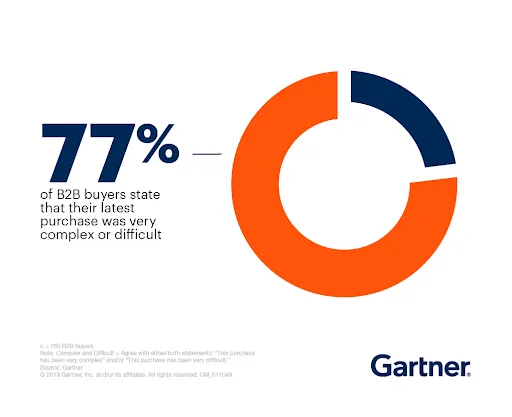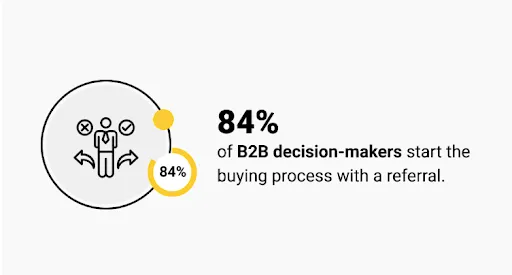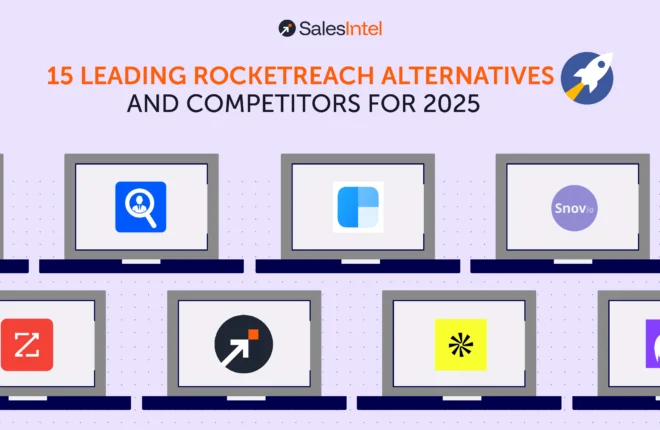Have you ever wondered why some B2B sales seem to close effortlessly while others drag on for months or even fall apart entirely? The answer lies in understanding the complex web of factors influencing buying decisions.
Did you know that 77% of B2B buyers describe their latest purchase as “very complex or difficult”? Understanding what drives B2B buying decisions is crucial for buyers and sellers, especially in a world where organizational goals, external pressures, and individual preferences influence decisions.

(Image source: Gartner)
This article will examine the key elements influencing B2B purchasing behavior, such as organizational, external, buyer-specific, information, relationship, and technological and data-driven factors. Ultimately, you’ll be better equipped to navigate and influence the complex B2B buying process.
Organizational Factors
Company Size and Structure
Companies’ size and structure greatly influence their buying behavior. Larger organizations with complicated hierarchies frequently have more established procedures that require the participation of stakeholders from several departments, including operations, finance, and information technology.
McKinsey’s research reported that decision-making in big companies can take 20% to 30% longer because of the involvement of multiple departments. For instance, a major corporation’s decision-making process may take longer when acquiring new software because it frequently involves input from numerous departments.
With their enticing flat architecture, smaller businesses can make decisions more quickly. However, they might benefit from a structured approach similar to a well-defined 7-step sales process that ensures consistency, efficiency, and improved sales performance.
Budget Constraints and Allocation
Every company operates within a budget, which affects what they can purchase. A smaller budget means clients will look first at lower-cost solutions, usually resulting in cheaper alternatives or more complex negotiations. On the other hand, organizations that have more financial flexibility may focus on quality, brand reputation, or long-term value over immediate cost savings.
Budget constraints can also dictate the timing of purchases. To comply with budget cycles, a business can, for example, postpone a significant acquisition until the following fiscal year. Anyone in B2B sales or procurement must be aware of these financial factors.
Internal Policies and Approval Processes
Many organizations, especially the larger ones, have these policies to ensure that anything you purchase aligns with broader business objectives and compliance requirements. For example, your company has a rule that requires you to obtain three quotes from distinct suppliers before approving an expenditure or insists on all technology purchases being routed through the IT department so they can check compatibility with pre-existing systems.
These processes are critical for accountability and governance but can also hinder purchasing. If a purchase has to go through multiple layers of approval, it might take weeks, or most likely months, to complete.
External Factors
Market Trends and Economic Conditions
Market trends and overall economic conditions profoundly impact B2B buying behavior. In strong economic climates, companies are more likely to take advantage of this strength (opportunity) and invest in expansion by making purchases of goods and services they think will boost their bottom line and operational efficiency. For instance, during periods of greater prosperity, businesses might invest more money in implementing new technology or growing their facilities to accommodate growing demand.
On the other hand, in cases of global depression or even decelerating economic growth, organizations are likely to absorb costs. For instance, during the Great Depression of the 1930s, global industrial production drastically reduced, money supply fell by nearly 30%, and many companies postponed capital expenditures, slashed budgets, and focused on survival rather than growth.
This may lead to such outcomes as an increased quantity of postponed consumption, slower rates of consumption, and higher shares of the focus on the lowest price.
Industry Standards and Regulations
Certain industries are highly regulated; therefore, companies that operate in them must ensure that the companies and/or individuals from whom they acquire supplies adhere to similar demanding industry and regulatory criteria. This is true for the pharmaceutical, financial, and healthcare businesses. These regulations usually address every aspect of conducting business, including product selection, purchases, and available vendors.
For example, in large organizations within these industries, a corporate learning platform is often utilized to provide specialized training that helps employees understand and navigate the complex approval processes for tools and suppliers. In pharmaceutical companies, there are rules of GMP concerning the purchase of equipment and materials. Similarly, banks and other financial institutions must adhere to cybersecurity and data protection regulations, influencing the software and IT services they can purchase. Political elements, such as modifications to national or international trade agreements or policy changes, may also be involved. Political factors, such as changes in government policies or international trade agreements, can also play a role.
Competitive Landscape
Businesses monitor their rivals closely and frequently modify their purchasing choices in reaction to pressure from the competition. Suppose a rival delivers a novel product or service and garners a substantial portion of the market. In that case, rivals will likely claim ownership of comparable technology or offerings to avoid being displaced from the market.
Many companies have adapted to the self-directed B2B buying journey trend in response to this competitive pressure. This shift sees buyers conducting extensive research independently and entering the decision stage before interacting with sales teams.
Buyer-Specific Factors
Role of Decision Makers and Influencers
In B2B, purchasing choices are not determined by a single person. It is a collaborative effort involving numerous decision-makers and influencers. This decision is usually shaped by various stakeholders, including CEOs, department heads, and outside consultants, each bringing their knowledge, interests, and concerns to the table.
According to Forbes, on average, a B2B buying group has 6 to 10 decision-makers, each contributing unique insights and requirements to the purchasing process. For instance, when a firm is in the process of acquiring a new software:
- IT Personnel: Focus on compatibility and technical requirements.
- Finance Department: Mostly concentrates on cost-effectiveness and ROI.
- End Users: Prioritize ease of use and user experience.
The ultimate decision is, however, made by the party most influential within the particular context; in most cases, this is a senior executive, a department head, a director, or a project manager.
Experience and Expertise of Buyers
B2B buying behavior is also significantly influenced by the experience and knowledge of the individuals participating in the purchasing process. Having gone through multiple buying cycles, seasoned consumers typically take a more systematic approach to making decisions. They will conduct an in-depth investigation, weigh several choices, and look for the best deal for their business.
For instance, a mature procurement manager in a certain firm will have specific standards that they factor into evaluating the particular vendors. Most of the time, these will involve using tools to make comparisons on things such as the features of the products, their prices, and even their total costs in the long run.
This is so because the more experienced buyer is likely to take his time to analyze his suppliers and come up with the best supplier through an analytical approach. In contrast, the less experienced buyer will rely on opinions, brand image, or even his sentiments. Developing a well-thought-out procurement plan can help such buyers make more informed decisions and build confidence in evaluating vendors objectively, reducing reliance on subjective factors.
Risk Aversion and Decision-Making Style
Risk-taking propensity and personal decision-making are other factors influencing B2B purchasing. Given their aversion to taking chances when faced with uncertainty, some decision-makers probably fall into the “risk-aversive” category. These individuals might prioritize safety, reliability, and proven solutions over innovative but untested options. They are likely to patronize those sources that have succeeded in establishing themselves within the market.
On the other hand, some buyers are more open to taking calculated risks if they believe they could lead to significant competitive advantages. Such decision-makers might be inclined to explore new technologies, products, or partnerships, even if some level of uncertainty is involved.
Information and Relationship Factors
Access to Information and Research
Buyers’ access to information enables them to make the right decisions; however, sellers must proactively provide the right information at the right time. For instance, a buyer will search for product features, reviews from other businesses within the same industry, or case studies of how the product works differently. Thus, companies that can provide as much information as is necessary, understandable, and easily found by a potential buyer will be seen as credible.
In addition, the research phase is not just about finding the best product or service but also assessing the vendor’s reliability. Buyers also seek proof of the vendors’ experience, including the white papers, customer references, and the vendor’s engagement in their industry forums. The more authoritative and trustworthy the vendor appears, the more likely they will be chosen.
Trust and Credibility
84% of B2B decision-makers start the buying process with a referral. This shows how crucial it is to have a solid reputation and network.

(Image source: cdn.prod)
Credibility can be established in several ways:
- Client Portfolio: A vendor with a strong portfolio of satisfied clients, positive testimonials, and industry awards will naturally be viewed as more credible.
- Transparent Communication: Clear and honest answers to buyer questions and consistent updates contribute significantly to building trust.
- Reputation: The overall reputation of a vendor in the industry, reinforced by public reviews and peer recommendations, plays a critical role in establishing credibility.
A lack of credibility or trust can be fatal in business. Buyers may search elsewhere even if a vendor offers a better product because they may have concerns about the vendor’s capacity to deliver it.
Relationship Building and Networking
Building strong relationships and effective networking is essential in B2B because people tend to do business with those they know. That is why relationships are based on trust, respect, and commercial value due to constant service provision. Quite often, a buyer has a number of options but selects the vendor with whom they have never had any problems, time conflicts, or issues concerning the quality of products or services.
Networking also has a critical role since it forms the foundation of the relationship. Forget about personal contacts; these days, so-called professional relationship management tools, such as LinkedIn, are invaluable. The best LinkedIn automation tools allow buyers to follow vendors, engage with their content, and assess their credibility through interactions and shared insights, ultimately helping them make more informed purchasing decisions.
Technological and Data-Driven Factors
Influence of Technological Advancements
Businesses must adjust their purchase selections when new technologies emerge to remain competitive. For instance, cloud computing has significantly changed businesses’ approach to IT infrastructure. Similarly, advancements in automation technology offer businesses equipment that helps increase efficiency in business operations.
To give a real-life example, it is better to incorporate the advanced use of robotics or IOT (Internet of Things) gadgets in the manufacturing industry to optimize. The application of such technologies is precipitated by the need to counter competition, reduce costs, and augment productivity. For B2B buyers, keeping an eye on technological trends is not just a matter of convenience; it is necessary under the principle of do-or-die importance.
Use of Data and Analytics
Nowadays, companies rely on data-driven insights to guide their buying behavior, guaranteeing that the purchased means will contribute to the appropriate achievement or realization of the company’s strategic goals and objectives. Analytics allows businesses to evaluate potential purchases more precisely, assessing factors like cost-effectiveness, ROI, and long-term benefits.
For example, a firm can decide to implement predictive analytics in demand forecasts to get the right stocks for purchase. By analyzing past sales data, market trends, and customer behavior, businesses are in a position to set the proper requirements that will enable them to fulfill the needs of their products and, at the same time, avoid stocking excess products and getting short of stock.
Additionally, data-driven decision-making extends to vendor selection. Companies can analyze and compare the performance of a given vendor to the others, the price at which various products are offered, and the responses of clients, and go for the best product regarding this aspect. Not only is it helpful in preventing wrong choices of purchases, but it is also used in improving the buying practices of businesses.
Conclusion
Understanding what affects B2B buyer behavior is super important. Organizational, technological, and data-driven factors all influence buying decisions. To succeed in B2B transactions, it’s essential to see how these factors are connected and stay on top of changes to stay competitive and set up for future growth.
Kateryna Kalnova is a chief editor at Snov.io. Her journey in the professional landscape began as a translator, where she honed her linguistic skills and developed a profound understanding of effective communication. Kateryna then seamlessly transitioned into the world of writing and editing. Now her key focus is to bring up-to-date information about all things sales, empowering professionals with the knowledge they need to excel in their roles.




